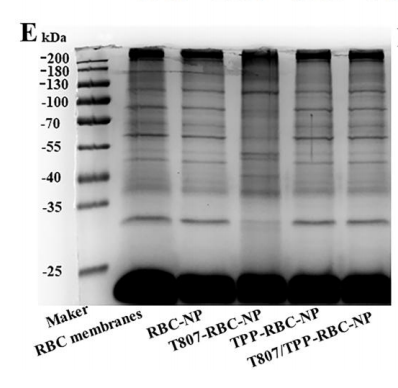文献:Neuronal Mitochondria-Targeted Delivery of Curcumin by Biomimetic Engineered Nanosystems in Alzheimer’s Disease mice
文献链接:https://xueshu.baidu.com/usercenter/paper/show?paperid=1y2p04p02y2q0t00su4f08a0rh796691&site=xueshu_se
作者:Chunhong Gao , Yuli Wang , Jiejie Sun , Yang Han , Wei Gong , Yi Li , Ye Feng , Hao Wang , Meiyan Yang , Zhiping Li , Yang Yang , Chunsheng Gao
相关产品:Amino-T807 and carboxy-TPP 氨基-T807/羧基-三苯基膦
原文摘要:Biomimetic nanotechnology represents a promising approach for the delivery of
therapeutic agents for the treatment of complex diseases. Recently, neuronal mitochondria have been proposed to serve as a promising therapeutic target for sporadic Alzheimer’s disease (AD). However, the efficient intravenous delivery of therapeutic agents to neuronal mitochondria in the brain remains a major challenge due to the complicated physiological and pathological environment. Herein, we devised and tested a strategy for functional antioxidant delivery to neuronal mitochondria by loading antioxidants into red blood cell (RBC) membrane-camouflaged human serum albumin nanoparticles bearing T807 and triphenylphosphine (TPP) molecules attached to the RBC membrane surface (T807/TPP-RBC-NPs). With the advantage of the suitable physicochemical properties of the nanoparticles and the unique biological functions of the RBC membrane, the T807/TPP-RBC-NPs are stabilized and promote sustained drug release, providing
improved biocompatibility and long-term circulation. Under the synergistic effects of T807 and TPP, T807/TPP-RBC-NPs can not only penetrate the blood-brain barrier (BBB) but also target nerve cells and further localize in the mitochondria. After encapsulating curcumin (CUR) as the model antioxidant, the research data demonstrated that CUR-loaded T807/TPP-RBC-NPs can relieve AD symptoms by mitigating mitochondrial oxidative stress and suppressing neuronal death both in vitroand in vivo. In conclusion, the intravenous neuronal mitochondria-targeted biomimetic engineered delivery nanosystems provides an effective drug delivery platform for
brain diseases.
Amino-T807 是一种 tau 蛋白显像剂的前体物质,主要作用于 tau 蛋白。Tau 蛋白是一种微管相关蛋白,在正常生理状态下,它能够与微管结合,促进微管的组装和稳定,维持细胞的正常形态和功能。然而在特定条件下tau 蛋白会发生过度磷酸化,导致其结构和功能异常,进而形成神经原纤维缠结,破坏神经元的正常功能和细胞间的信号传递。Amino-T807 能够与异常的 tau 蛋白特异性结合,通过放射性标记等方法,可以实现对体内 tau 蛋白的显像和定量分析。基于此通过将抗氧化剂装载到红细胞(RBC)膜伪装的人血清白蛋白纳米颗粒中,携带T807和三苯基膦(TPP)分子(T807/TPP-RBC-NPs),制备方生纳米系统。过程如下:

图:DSPE-PEG3400-T807的制备原理
功能缀轭物的合成
采用nhs-氨基偶联反应合成了DSPE-PEG3400-T807。简单地说,将氨基-t807溶解在氯仿中,加入到DSPE-PEG3400-NHS中,氨基-t807与脂质的摩尔比为1.5: 1。混合物在室温黑暗中轻轻搅拌一夜。所得到的上清液被透析用蒸馏水浸泡。纯化的透析液冻干并在-20°C下保存。采用nh2-羧基偶联反应制备了DSPE-PEG2000-TPP。羧基-TPP与DSPE-PEG2000-NH2(1.5: 1摩尔比)在含EDC(1-(3-Dimethylaminopropyl)-3-ethylcarbodiimide盐酸盐的氯仿中)和NHS(N-羟基琥珀酰亚胺)中反应。在室温下温和混合12小时。然后在透析袋中透析这些反应物,以去除有机溶剂和未偶联的反应物。溶液冻干,在-20°C下保存。采用乳化超声法制备了HSA纳米颗粒(NPs),然后制备RBC-NPs,最终成功制备T807/TPP-RBC-NPs。

图:各种仿生配方和红细胞膜的代表性SDS-PAGE蛋白分析
结论:在T807和TPP的协同作用下,T807/TPP-RBC-NPs不仅能穿透血脑屏障(BBB),还能以神经细胞为靶点,进一步定位于线粒体。将姜黄素(CUR)作为模型抗氧化剂封装后,研究数据表明,装载CUR的T807/TPP-RBC-NPs在体内内外均可通过减轻线粒体氧化应激来缓解AD症状。T807/TPP-RBC-NPs具有合适的理化性质和RBC膜的生物学功能,能够稳定并促进药物缓释,改善生物相容性和长期循环。

 2025-02-11 作者:ZJ 来源:
2025-02-11 作者:ZJ 来源:

